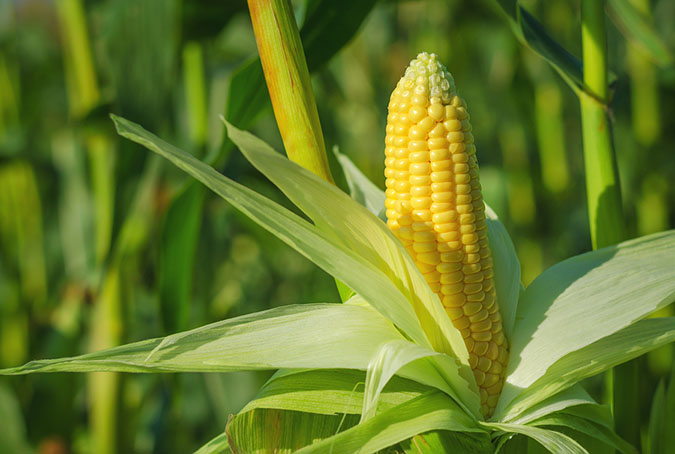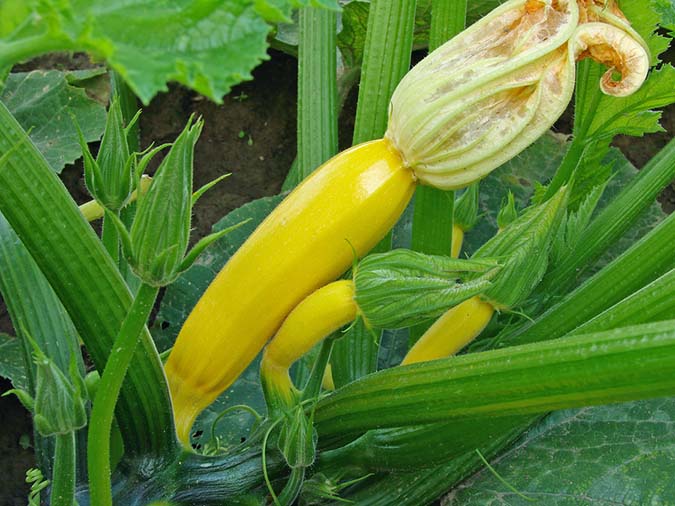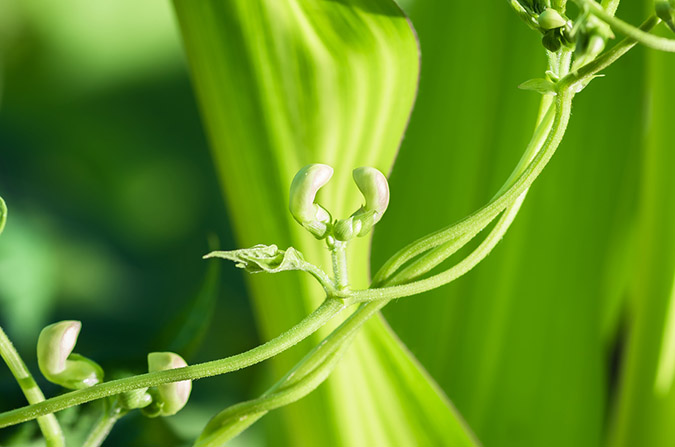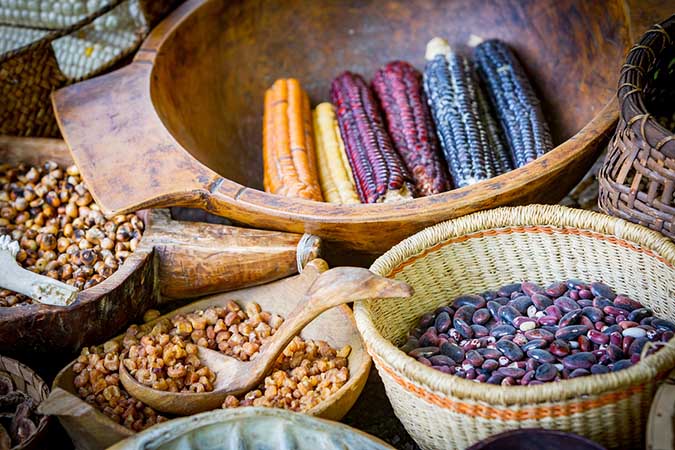Imagine a small garden that produces an above-average harvest, yet needs minimal water, fertilizer, and weeding—and, as a bonus, leaves your soil more fertile at the end of the growing season. Some might call that a dream come true, but what it’s really called is a Three Sisters Garden.
Yet this remarkably savvy strategy for growing corn, beans, and squash wasn’t developed by a Ph.D. in a modern research garden. Instead, it began centuries—perhaps millennia—ago as a Native American agricultural tradition.



What is a Three Sisters Garden?
Unlike today’s gardens where plant varieties are separated by straight rows, a Three Sisters Garden allows corn, bean, and squash plants to grow together and benefit from each other.
The beauty of a Three Sisters Garden comes from the symbiotic relationship between these three crops.
- As corn stalks grow, they create poles for beans to climb on to gain support and find sunlight without getting outcompeted by the sprawling squash.
- The bean roots also help stabilize the corn in heavy winds and fertilize it by “fixing” nitrogen from the air into a form that corn and squash roots can absorb.
- The squash’s large leaves are prickly enough to deter pests from coming close, and they shade out weeds while keeping the soil moist.1)
History of the Three Sisters Garden
When agriculture began in the Americas 7,000 years ago, it quickly changed the landscape and local cultures beyond recognition.
Maize, beans, and squash were domesticated in Central and South America and gradually made their way to the American Midwest.2)
Different Native American tribes began to integrate these crops into their horticultural traditions, though the Iroquois (also called the Haudenosaunee) first used the phrase “Three Sisters” to describe the practice of growing them together in highly productive garden plots.
Over the centuries, the Three Sisters gained physical and spiritual importance for the Iroquois. Their planting method involved sowing all three seeds in fertilized mounds that prevented the young plants from getting waterlogged.
Women then weeded and hoed these mounds throughout the summer and harvested the crops in the early fall before drying and storing them for winter. Celebrated as a gift from the Great Spirit, corn, beans, and squash were eaten together for most meals.
American colonists first learned of Three Sisters Gardens over 300 years ago.
Since they were used to straight, orderly farm fields, most settlers first dismissed these densely planted gardens as wild.
However, they soon learned that this biointensive combination-planting method was perfectly suited for the region, as cleared land was difficult to maintain and small Iroquois garden plots needed to produce higher yields than European ones.
Today, a Three Sisters Garden is a great example of an ecological guild in America because each plant directly benefits the others.
Grown together, Three Sisters crops produce more food with less water and fertilizer.
In fact, Three Sisters Garden plots tend to produce 20 percent more calories than when the same crops are grown apart.3)
A Nutritional Cornucopia
Not only are the Three Sisters naturally suited to grow well together, they also pack a powerful nutritional punch. In fact, a diet of corn, beans, and squash is nutritionally balanced without the need for other protein sources.
Corn kernels are rich in carbohydrates and become a complete protein source when eaten with beans.
Full of vitamins and minerals, squash rounds out the diet nutritionally.
Making them even more valuable, corn, beans, and squash all could be dried and eaten throughout the winter.4) When combined with other vegetables native to America like peppers and tomatoes, the Three Sisters fueled culinary creativity and promoted health all year long.
Three Sister Variations
Not all Three Sister gardens are the same.
While squash, beans, and corn were important food crops throughout America, many native cultures made variations on the growing method to better fit their local conditions.
For example, throughout the dry Southwest, the Three Sisters were often planted in separate fields with wide plant spacing to maximize the use of a limited water supply.5)
In some places, a fourth sister joined the trio. Sunflowers attracted insect pollinators to the garden while distracting birds from the corn and providing support for bean vines.
Throughout the Southwest, tobacco was interplanted with the Three Sisters as a ceremonial plant.
Likewise, watermelons and gourds were easily substituted for squash.

Tips for Getting Started
When you follow the Three Sisters method today, you equip your garden with the building blocks it needs to grow flavorful plants that are well suited to your natural conditions.
You can also help preserve a Native American heritage and benefit from centuries of horticultural innovation and experimentation by growing your own Three Sisters Garden at home.
Layout
There are plenty of variations for laying out a Three Sisters Garden, but it’s always best to plant your corn in clusters instead of rows. This makes it easier to attract pollinating insects for your squash plants and for wind-pollinated corn tassels to fertilize each other.7)
Make sure you choose a spot with plenty of direct sunlight and a neutral pH level (6.0–7.0 is best).
Minimal space is needed for a Three Sisters Garden. A 10-foot-by-10-foot plot tends to be ideal.That’s a small enough space to be fairly simple to prepare and maintain while ensuring that you sow enough corn (about 10–20 plants) for it to cross-pollinate.
To set up a traditional Three Sisters Garden in a 10-foot-by-10-foot plot, mark off three rows spaced five feet apart. Each row will have five 18-inch mounds, alternating corn/bean mounds with squash mounds.8)
Planting

Sowing a Three Sisters Garden takes a little longer from start to finish, but the steps are simple—and the results are oh so worth it!
- Start by fertilizing the garden bed with your favorite amendments.
- Form the soil into flat mounds that are a foot high and 18 inches in diameter.
- Alternate the corn/bean mounds with the squash mounds.
- Stagger the planting by species to create a “stacked” garden that gives the corn and/or sunflowers a few weeks’ head start. This also prevents the plants from outcompeting each other in their beginning growth stages.
- Once the danger of frost has passed, plant four kernels of corn an inch deep and six inches apart, with each kernel forming one of the four points of a diamond shape.
- Once the corn reaches five inches tall, plant four bean seeds in a pattern that adds corners to your diamond shape, effectively making it a square.
- Squash seeds should be planted one week later in the remaining mounds. In each mound, plant three squash seeds four inches apart in a triangle shape.9)
- Make sure to hill up the soil as it starts to level out so that there is plenty of material for the root systems to work with.
Maintenance
As the Three Sisters grow together, you will notice the bean sprouts starting to climb the corn stems, and heavy squash leaves starting to fan out along the ground.
While squash leaves help shade out weeds as they grow, it’s best to regularly weed your plot when the plants are young to prevent them from getting outcompeted. Laying down a layer of organic mulch is also a good way to help the soil retain moisture on hot summer days.
Insect pests are likely to find your garden as exciting as you do, so make sure to watch for squash bugs, squash vine borers, and corn earworms.
A drop of vegetable oil on the tips of corn ears can help fend off an invasion, and you can keep your beans healthy by working them only when the plants are dry.10)
To preserve the purity of heirloom varieties, you can hand-pollinate your corn plants. Simply place waxed paper bags over the corn silk to prevent pollen from getting in. When the tassels are two inches out, remove the bags and shake your preferred pollen on the silks before replacing the bags to prevent contamination.
Harvest
By mid-to-late summer, your Three Sisters Garden will be brimming with produce.
Summer squash is often the first to mature. You can harvest the squashes once they are two inches in diameter, as they taste best when small and tender.
Winter squash needs to be harvested when the outside skin is hardened and the squash has lost its natural sheen. Make sure to cleanly slice the stem with a knife, and leave the stem on the squash to help it stay fresh for several months.
Green beans are best harvested when the pods are slim and tender. So long as you prevent your beans from over-maturing and going to seed, they should produce vigorously for a month or two. Take care not to damage the vines as you pick them, and you should enjoy fresh beans for much of the summer.
Ears of corn are ready to pick about 20 days after the first silk stacks appear. You’ll know the ears are mature when the silks are dry and brown and the kernels are smooth and plump, and emit a milk-like juice when you puncture them with your thumbnail. Simply twist off each ear when ripe, and eat immediately for the best flavor.

Best Three Sister Varieties to Grow
Not every variety of corn, beans, and squash grows well in a Three Sisters Garden.
Oftentimes, traditional heirloom varieties are better suited to the specific growing conditions that companion planting calls for.
Below are varieties of corn, beans, and squash that are well suited for Three Sisters Gardens.
Corn
Sweet corn was a staple food in Native American diets,11) and most varieties grow well using the Three Sisters method. Native corns tend to be heartier and more drought resistant than industrial varieties, so make sure you look to corn varieties that are naturally suited for your growing conditions.
It’s best to choose a tall variety so that your bean plants have plenty of room to grow.
Pencil Cob corn is a prolific, six-foot variety, and Flor del Rio is an excellent heirloom popcorn.
If water is an issue, Southwestern varieties like Tohono O’odham and Hopi mature fast and use less water, but their short stature makes it harder for them to support beans.
Beans
When choosing your beans, it’s essential that you select pole beans instead of bush beans to ensure they trellis themselves on the corn stalks. Common pole bean varieties include pinto, kidney, black, lima, and navy.
Ideally, you should grow “corn beans,” as they have adapted to growing in shady conditions and won’t suffer from overcrowding.12)
Few Native American bean species have been preserved, but the Ohio pole bean and Amish Nuttle are two options.13) Other versatile pole beans include Blue Lake, Kentucky Wonder, O’odham Vayos, and Four Corners Gold. If you do end up with a short corn variety like Tutelo Strawberry, you might pair it with a bean variety like Wild Pigeon, since it isn’t aggressive enough to overpower the shorter corn.
Squash
Unfortunately, few squash varieties that were common in traditional Native American gardens are still in use. While Yellow Summer Crookneck and Early White Scallop date back at least to the 1700s, the varieties available today are significantly different from the originals.
The best squash variety depends on the amount of space you have to work with.
If your garden provides ample room for plants to sprawl, go for a winter squash variety like Tarahumara Pumpkin or Magdalena Big Cheese.
Tighter arrangements better suit Yellow Crookneck squash, Ponca butternut, and Dark Star zucchini.
A Harvest of Heritage
A delightful combination of science and history, the Three Sisters Garden nurtures both body and soul. Yes, it provides larger harvests with less work and water. But it also connects gardeners with centuries of heritage – and lets them play a vital role in ensuring that this wondrous planting method survives to nourish yet another generation.
Article from The Grow Network. If you want more great advice like this, be sure to check out Grow Your Own Groceries.
If you like this idea, be sure to share it with your friends and inspire someone you know. Anything becomes possible with just a little inspiration

